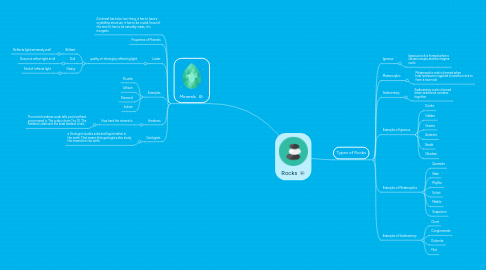
1. Minerals
1.1. A mineral has to be non-living, it has to have a crystalline structure, it has to be a solid (most of the time) It has to be naturally made, it is inorganic.
1.2. Properties of Minerals
1.3. Luster
1.3.1. quality of shining by reflecting light
1.3.1.1. Brilliant
1.3.1.1.1. Reflects light extremely well
1.3.1.2. Dull
1.3.1.2.1. Does not reflect light at all
1.3.1.3. Glassy
1.3.1.3.1. Kind of reflects light.
1.4. Examples
1.4.1. Flourite
1.4.2. Lithium
1.4.3. Diamond
1.4.4. Indium
1.5. Hardness
1.5.1. How hard the mineral is.
1.5.1.1. The mohs hardness scale tells you hard hard your mineral is. The scale is from 1 to 10. The hardest is diamond the least hardest is talc.
1.6. Geologists
1.6.1. a Geologist studies solid and liquid matter in the earth. That means that geologists also study the minerals in the earth.
2. Types of Rocks
2.1. Igneous
2.1.1. Igneous rock is formed when a volcano erupts and the magma cools
2.2. Metemorphic
2.2.1. Metamorphic rock is formed when heat+pressure is applied to another rock to form a new rock
2.3. Sedimentary
2.3.1. Sedimentary rock is formed when sediments combine together.
2.4. Examples of Igneous
2.4.1. Diorite
2.4.2. Gabbro
2.4.3. Granite
2.4.4. Andesite
2.4.5. Basalt
2.4.6. Obsidian
2.5. Examples of Metamorphic
2.5.1. Quartzite
2.5.2. Slate
2.5.3. Phyllite
2.5.4. Schist
2.5.5. Marble
2.5.6. Soapstone
2.6. Examples of Sedimentary
2.6.1. Chert
2.6.2. Conglomerate
2.6.3. Dolomite
2.6.4. Flint
